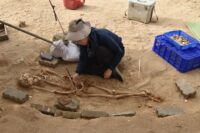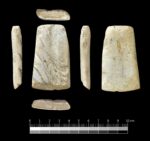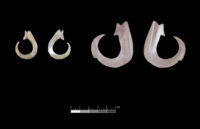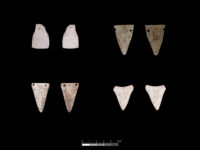 Archaeologists have discovered a 4,000-year-old burial ground and shell tool processing site in Kenting National Park on the southernmost tip of Taiwan. This is the first prehistoric shell tool processing site discovered in Taiwan, and the oldest and largest found in any Pacific island.
Archaeologists have discovered a 4,000-year-old burial ground and shell tool processing site in Kenting National Park on the southernmost tip of Taiwan. This is the first prehistoric shell tool processing site discovered in Taiwan, and the oldest and largest found in any Pacific island.
 The site was discovered in 2017 during a renewal project to convert the crumbling shopfronts in Eluanbi Park into new green buildings. Contractors stumbled onto human remains, some in slate coffins, and shell tools just under the surface of the soil. Construction work was stopped while archaeologists from National Tsing Hua University’s (NTHU) Institute of Anthropology surveyed the site.
The site was discovered in 2017 during a renewal project to convert the crumbling shopfronts in Eluanbi Park into new green buildings. Contractors stumbled onto human remains, some in slate coffins, and shell tools just under the surface of the soil. Construction work was stopped while archaeologists from National Tsing Hua University’s (NTHU) Institute of Anthropology surveyed the site.
Between 2019 and 2021, the team unearthed a large number of relics and artifacts, including 51 skeletons, 10 of which were buried in slate coffins with coral funeral objects, [Chiu Hung-lin, NTHU Institute of Anthropology associate professor] said.
Among the findings were several finished and unfinished shell tools, as well as relics that indicated it was a site for making those tools, which provided proof that the early inhabitants of Eluanbi used “unique” shell-crafting techniques, Chiu said.
The site also offered insights into the funeral customs of the people in those times, he said, adding that anthropologists could also make new discoveries by studying the human remains found at the site.
 The processed shell finds range widely in design and function. There are practical tools like a shell adze used for cutting, as well as ornaments like shell and shark tooth pendants. The presence of intermediate stages — semi-finished objects, blanks — and processing waste is evidence of an extensive manufacturing operation.
The processed shell finds range widely in design and function. There are practical tools like a shell adze used for cutting, as well as ornaments like shell and shark tooth pendants. The presence of intermediate stages — semi-finished objects, blanks — and processing waste is evidence of an extensive manufacturing operation.


I suspect that the fish hooks may have been more decorative than functional because of the small gap between the point and the shank and the way the point is aimed at the shank. It would have been very difficult to hook a fish with one of these.
The “ancient past” is possibly a little more ancient than commonly thought.
Apparently, in Hawaiian, ‘Makau‘ just means hook, there are/ were several Formosan languages, while the Maori word seems to be ‘Matau‘:
en.wikipedia.org/wiki/Hei_matau
——–
“These fishhooks were the result of at least one thousand years of Hawaiian development and refinement. […] Lately, their shapes have been copied by Hawaii craftsmen and are worn as popular pendants. Hawaiian fishhooks, while made for a practical purpose, have also become creations of beauty and refinement that are still appreciated today and serve to connect us with their ancient past.” – honolulumagazine döt com/makau-hawaiian-fishhooks/
——–
collections.tepapa.govt.nz/object/130312
collections.tepapa.govt.nz/category/331915
“The Austronesian expansion (also called the “Out of Taiwan” model) is a large-scale migration of Austronesians out of Taiwan, occurring around 1500-1000 BCE.” cf.:
en.wikipedia.org/wiki/Austronesia#Austronesian_expansion